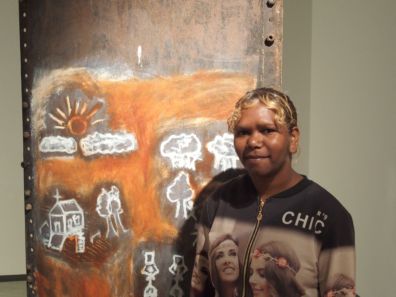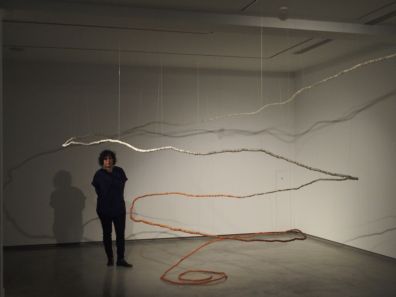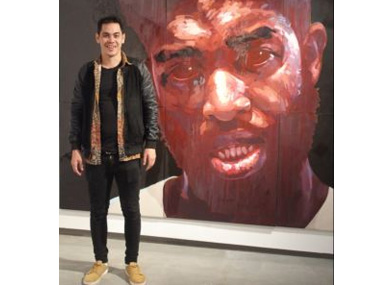DOWN TO EARTH

Titjikala artist, Heather Douglas with one of the former water-tank panels she's painted for 'Primavera' 2015 at the MCA.
Posted by Jeremy Eccles | 23.09.15
Gallery: Museum of Contemporary Art
Dates:
22.09.15
: 06.12.15
Featuring the work of seven artists from southern Australia, Primavera 2015 opened to the public on 22 September at Sydney's Museum of Contemporary Art. The artists in this year’s curation extract earth materials, work with sound, video and installation and create assemblages reflecting strategies of survival and the revival of ancestral forms of cultural production. The exhibition is curated by Sydney-based Aboriginal artist, Nicole Foreshew, 2015 MCA Curatorial Fellow.
Primavera is the MCA’s annual exhibition of young Australian artists aged 35 and under. Since 1992, the series has showcased the works of artists and curators in the early stages of their career, many of whom, like Shaun Gladwell and Jess MacNeill have gone on to exhibit nationally and internationally. In 2015, Primavera celebrates its 24th edition; Foreshew is its first Indigenous curator.
Hailing from four states and territories across Australia, plus PNG, the young artists in this year’s exhibition are: Abdul Abdullah (born in 1986, Perth, WA, lives and works in Sydney), Heather Douglas (born in 1994, Titjikala, NT, where she still lives and works), Taloi Havini (born in 1981, Arawa, autonomous region of Bougainville, migrated to Australia in 1990, lives and works in Melbourne), the brothers Vincent & Vaughan O’Connor (both born in 1985, Sydney where they still live and work), Steaphan Paton (born in 1985, Mildura, VIC, lives and works in Melbourne) and Lucy Simpson (born in 1981, Sydney where she still lives and works).
Primavera 2015 curator Nicole Foreshew explains: “The practices foregrounded in this exhibition, and the cultures and conditions of life, work and history that they emerge from, are situated within the broad experience of a resurgent ‘Global South’, within which peoples belonging to a diversity of cultures question received ideas of identity, culture and power.”
Foreshew adds: “The importance of this extends to Aboriginal art-making in the ‘South’ of Australia. There is a commonly held perception that cultural practices and activities have ceased, or have changed too much to have any value or visible relevance to broad audiences. Yet as the work of artists in this year’s 'Primavera' demonstrates, Aboriginal art practices emerging from the wreckage of first contact and generations of colonial impacts are assuming an increasingly important role in the continuation of our nation’s cultural strength.”
So Steaphan Paton recreates the shields of his Gunai ancestors, cutting bark from trees on his Country – and then dressing in European camouflage to fire arrows into them. St Sebastian, anyone??? Well Steaphan reckons the saint didn't die from his wounds, so he's referencing Gunai survival with the scars they've suffered....“a meditation of the politics of grief and healing”.
Lucy Simpson hails from Yuwaalaraay Country in North West NSW, and has named her ochre-stained and knotted string weaving 'Yilaalu', meaning both 'a long time ago' and 'a long time to come' in reflection of the Yuwaalaraay Dreaming. She's also also availed herself of a British Council scholarship to examine Indigenous artefacts from the NW in the British Museum, reproducing a group of vessels in paperclay.
In a sense, the Yankunytjatjara-speaking Titjikala resident, Heather Douglas doesn't need to rediscover her culture, which has been with her throughout her 21 year life, thanks to an upbringing on the edge of the Simpson Desert by her grandmothers. But of course she's too young to be able to share the complexities of that culture yet. So it's the cross-cultural history of her family that appears in the eroded hanging panels from an old water-tank on Maryvale cattle-station – a white construction that allowed Anangu to live on and work the station for them. Her grandfather etched his initials deep into the steel surface on one side; on the other, the pink-substrata that rose with water from the artesian bore has crystallised on the surface to make its own landscape art. She's added text and designs recording the water-fetching her women forbears had to do, the clothes-washing before Sunday church and a sense of the drought and flood existence that made the APY Lands so marginal for white farmers.
Taloi Havini, a meri Buka from the Nakas clan on the contended island of Bougainville fled as a child from the war on that island with her activist father, Moses. But she's been back since the troubles died down to recapture aspects of her culture – the pottery of the matrilineal Malasang village, for instance, and photographic evidence of Rio Tinto's infamous Panguna mine. Havini's whirling assemblage of ceramic discs that emulate the strings of shell money still valid around the Pacific in ceremony reflects the fact that the shells are only found on Solomon islands like Bougainville.
Emigre from the West, Abdul Abdullah is the best known of these young artists with an Archibald entry to his name – a name which suggests Afghanistan or Syria in crisis, but is in fact 7th generation dinky-die Aussie! Do I hear the growl of a camel??? However, 9/11 happened, and a Muslim name re-made him an outsider – painting his striking portraits of enforced outsiders, Caliban and Sycorax for Primavera. He knows his Tempest too; though the MCA's unfortunate text description of Caliban as “deformed and depraved” somewhat undercuts Propero's slave's 'natural' right to the island of which the Italian duke had deprived him and his mother. I seem to recollect Capt Cook using somewhat similar terms about Australia's Indigenous population! Abdullah offers neither deformity nor depravity in his faces, only pathos and survival.
The curator who's pulled this almost-Indigenous vision together, Nicole Foreshew is also a Sydney-based artist – under 35, like her selections. She is a member of the Wiradjuri nation, in Central West NSW, and works across a range of media, from photomedia and design to sculpture, film and video.
In 2014 Nicole was awarded the Parliament of NSW Aboriginal Art Prize and the Arts NSW Aboriginal Arts Fellowship for her project Grounded. In 2012 she had been resident artist at the Darling Fonderie studios, Montreal and was awarded College of Fine Arts (COFA) Professional Development Award.
Nicole has also taken part in several notable group shows across Australia and internationally, most notably Maamungun Compatriots, a group exhibition with works by Michael Riley and Jonathan Jones at Lalit Kala Akademi, New Delhi as part of Oz Fest Festival in 2012, Shadowlife at Bendigo Art Gallery, curated by Natalie King and Djon Mundine in 2013, and a major public artwork commission born in darkness before dawn, for the City of Sydney, also in 2013. Nicole has shown at Carriageworks and in the NATSIAAs. In 2015, she is the Curatorial Fellow at the Museum of Contemporary Art. The MCA Curatorial Fellowship is supported by the Australian Government through the Australia Council, its arts funding and advisory body.
Nicole will be in conversation with Primavera artists on Thursday 24 September between 6:30 and 7:30pm. And don't miss the glittering new Daniel Boyd wallscape as you come into the MCA.
URL: http://www.mca.com.au/exhibition/primavera-2015-young-australian-artists/
Share this:
»  del.icio.us
»
del.icio.us
»  Digg it
»
Digg it
»  reddit
»
reddit
»  Google
»
Google
»  StumbleUpon
»
StumbleUpon
»  Technorati
»
Technorati
»  Facebook
Facebook
Contact Details
Gallery: Museum of Contemporary Art
Contact: Curator, Aboriginal and Torres Strait Islander Programs
Telephone: +61 2 9245 2400
Address: Circular Quay West George Street The Rocks Sydney 2000 NSW
Gallery: Museum of Contemporary Art
Contact: Curator, Aboriginal and Torres Strait Islander Programs
Telephone: +61 2 9245 2400
Address: Circular Quay West George Street The Rocks Sydney 2000 NSW

Bougainville's Taloi Havini amidst the whirls of her shell-money construction, 'Beroana' (2015)

Primavera artist, Abdul Abdullah stands by his 'Caliban'
Where is the exhibition?
Further Research
Gallery: Museum of Contemporary Art
Artists: Abdul Abdullah | Daniel Boyd | Heather Douglas | Jonathan Jones | Lucy Simpson | Michael Riley | Nicole Foreshew | Steaphan Paton | Taloi Havini
News Tags: Jeremy Eccles | MCA | Museum of Contemporary Art | Nicole Foreshew | Primavera
News Categories: Art Prize | Australia | Blog | Exhibition | Industry | News
Exhibition Archive
- 10.10.17 | TARNANTHI 2017
- 11.08.17 | Natsiaas 2017
- 20.07.17 | APY ART DOMINATES THE WYNNE
- 17.07.17 | Anangu Artist Wins $100,000 Prize
- 14.07.17 | The End of AAMU
- 11.07.17 | ART ACROSS THE COUNTRY
- 11.07.17 | TARNANTHI IN OCTOBER
- 05.07.17 | TJUNGUṈUTJA - from having come together
- 13.06.17 | Ghost-Nets Straddle the World
- 07.06.17 | Grayson Perry Going Indigenous?
- 05.06.17 | Barks Bigger than Ben Hur
- 27.05.17 | NGA QUINQUENNIAL 2017
- 21.05.17 | Blak Douglas Finds Home at the NGA
- 21.05.17 | BRIAN ROBINSON WINS HAZELHURST WOP
- 18.05.17 | PARRTJIMA 2.0
Advertising

